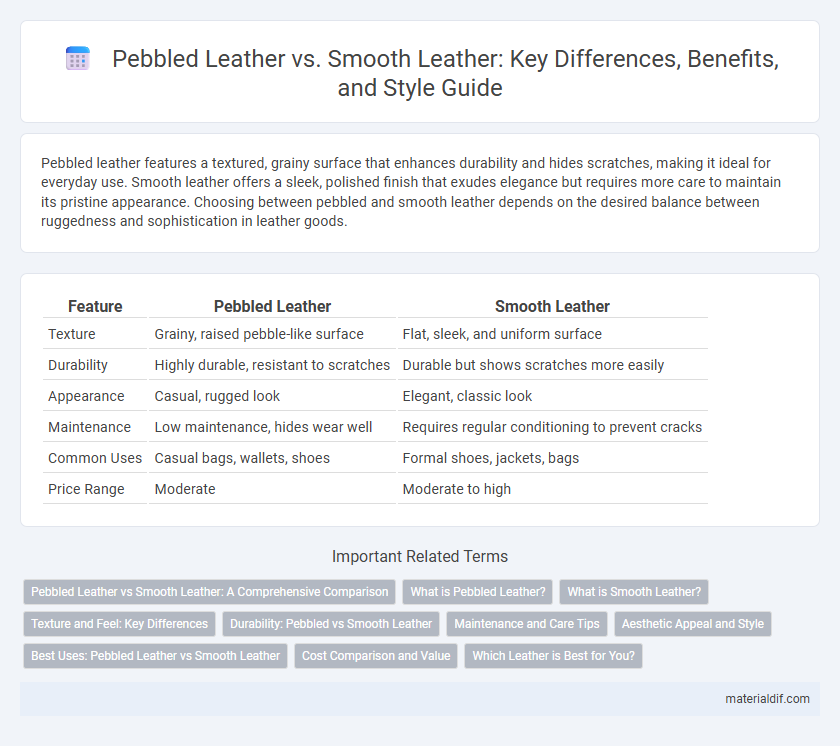Pebbled leather features a textured, grainy surface that enhances durability and hides scratches, making it ideal for everyday use. Smooth leather offers a sleek, polished finish that exudes elegance but requires more care to maintain its pristine appearance. Choosing between pebbled and smooth leather depends on the desired balance between ruggedness and sophistication in leather goods.
Table of Comparison
| Feature | Pebbled Leather | Smooth Leather |
|---|---|---|
| Texture | Grainy, raised pebble-like surface | Flat, sleek, and uniform surface |
| Durability | Highly durable, resistant to scratches | Durable but shows scratches more easily |
| Appearance | Casual, rugged look | Elegant, classic look |
| Maintenance | Low maintenance, hides wear well | Requires regular conditioning to prevent cracks |
| Common Uses | Casual bags, wallets, shoes | Formal shoes, jackets, bags |
| Price Range | Moderate | Moderate to high |
Pebbled Leather vs Smooth Leather: A Comprehensive Comparison
Pebbled leather features a textured surface characterized by a raised, grainy pattern that enhances durability and hides scratches better than smooth leather. Smooth leather boasts a sleek, uniform finish prized for its refined appearance and ease of cleaning but tends to show wear and imperfections more readily. Choosing between pebbled and smooth leather depends on the desired aesthetic, maintenance preferences, and usage demands, with pebbled leather offering increased resilience and smooth leather delivering classic elegance.
What is Pebbled Leather?
Pebbled leather is characterized by its textured surface created through a specialized embossing process that raises small, rounded bumps resembling natural pebble patterns. This type of leather often uses cowhide or lambskin and is prized for its durability, resistance to scratches, and distinct tactile feel. Compared to smooth leather, pebbled leather offers enhanced grip and a more casual, rugged aesthetic, making it ideal for accessories like handbags, wallets, and footwear.
What is Smooth Leather?
Smooth leather is a type of leather characterized by its even, flat surface, achieved through careful sanding, buffing, and finishing processes that eliminate natural grain textures. It offers a sleek, polished appearance and is often used in luxury goods, footwear, and high-end accessories due to its refined look and feel. Unlike pebbled leather, smooth leather lacks the raised, textured pattern, making it more prone to visible scratches but easier to clean and maintain a glossy finish.
Texture and Feel: Key Differences
Pebbled leather features a textured surface with raised, grainy patterns that offer a tactile, rugged feel, enhancing grip and durability. Smooth leather, by contrast, has a sleek, uniform texture with a polished finish that provides a softer, more refined touch. The key difference lies in the tactile sensation and visual texture, influencing both aesthetic appeal and functional usage.
Durability: Pebbled vs Smooth Leather
Pebbled leather exhibits higher durability due to its raised, textured surface that conceals scratches and scuffs more effectively than smooth leather. The dense grain structure in pebbled leather enhances resistance to wear and tearing, making it ideal for high-use items like bags and footwear. Smooth leather, while elegant and easy to clean, tends to show marks and signs of wear faster, requiring more careful maintenance to preserve its appearance.
Maintenance and Care Tips
Pebbled leather requires less frequent conditioning due to its textured surface, which helps conceal scratches and wear, making it ideal for everyday use. Smooth leather demands regular cleaning and conditioning with specialized leather care products to maintain its sleek appearance and prevent cracks. Both types benefit from avoiding prolonged exposure to moisture and extreme temperatures, using leather protectants, and proper storage to extend their lifespan.
Aesthetic Appeal and Style
Pebbled leather offers a textured, grainy surface that enhances grip and hides scratches, making it ideal for casual and rugged fashion styles. Smooth leather presents a sleek, polished finish that exudes elegance and sophistication, commonly favored in formal accessories and high-end apparel. The choice between pebbled and smooth leather depends on the desired aesthetic appeal, with pebbled emphasizing durability and character while smooth highlights refinement and a classic look.
Best Uses: Pebbled Leather vs Smooth Leather
Pebbled leather's textured surface makes it ideal for high-wear items like handbags and wallets, offering enhanced scratch resistance and durability. Smooth leather provides a sleek, polished appearance suited for formal footwear, dress shoes, and luxury accessories requiring a refined finish. Both types serve distinct purposes: pebbled leather excels in casual, rugged use while smooth leather is preferred for elegant, sophisticated products.
Cost Comparison and Value
Pebbled leather often carries a higher price tag than smooth leather due to its intricate texturing process, which enhances durability and hides wear over time, offering better long-term value. Smooth leather, while generally more affordable initially, may show scratches and aging more prominently, potentially necessitating more frequent maintenance or replacement. Evaluating cost against durability and aesthetic longevity reveals pebbled leather as a worthwhile investment for premium leather goods.
Which Leather is Best for You?
Pebbled leather offers a textured surface that is more resistant to scratches and wear, making it ideal for everyday use and durability. Smooth leather provides a sleek, polished appearance, favored for formal accessories but requires careful maintenance to avoid scuffs. Choosing between pebbled and smooth leather depends on your lifestyle needs and the balance between durability and aesthetic preference.
Pebbled leather vs Smooth leather Infographic

 materialdif.com
materialdif.com